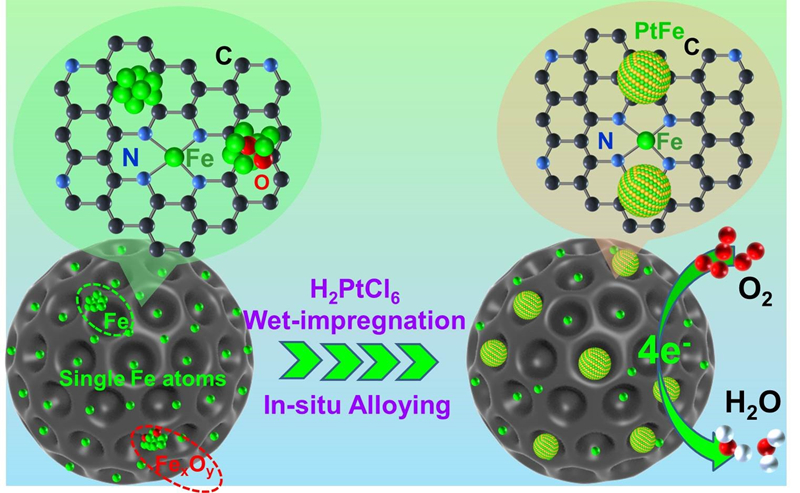
Pt-based intermetallic alloys with high activity and stability are promising for accelerating the cathodic oxygen reduction reaction (ORR) and large-scale application of proton exchange membrane fuel cells.
Atomically dispersed Fe-N-C catalysts play a significant role in promoting the efficiency of loaded PtM (M=Fe, Co, Ni, etc.) alloys as the supports towards ORR. However, iron nanoparticles and iron oxides that are not stable and efficient for ORR often form during Fe-N-C synthesis. How to make good use of the hybrid Fe-N-C with iron nanoparticles or oxides doping for boosting efficiency of Pt is still challenging.
Researchers from the Qingdao Institute of Bioenergy and Bioprocess Technology (QIBEBT) of the Chinese Academy of Sciences (CAS) and their collaborators have fabricated highly dispersed PtFe nanoparticles loaded on mesoporous Fe-N-C using mesoporous hybrid Fe-N-C as a model support through the in-situ alloy strategy.
The results were published in Journal of ACS Sustainable Chemistry & Engineering on June 26.
They found that H2PtCl6 could be adsorbed into the mesoporous hybrid nanostructure mainly doped with Fe single atoms and small amounts of Fe-based nanoparticles and oxides. And it could be reduced to Pt and in situ alloyed with the above-mentioned three iron species during the subsequently thermal treatment.
Systematically characterizations indicated the finally obtained catalysts were composed of PtFe alloy with atomic ratio of 1:1 and the support was atomically dispersed Fe-N-C without other phases doping.
The synthesized best-performance catalyst delivered a high potential of 0.925 V at current density of 3 mA cm-2 and achieved a high mass activity of 497.5 mA mgPt-1 at 0.9 V for the ORR in 0.1 M HClO4. More importantly, only 17.9 % mass activity loss was observed after 10k potential cycles of accelerated deterioration test.
"The findings provide a new direction for the rational design of highly efficient Pt-based electrochemical reaction catalysts towards ORR using the impure atomic Fe-N-C supports," said Prof. LIANG Hanpu from QIBEBT, corresponding author of the study.

In-situ reduction and alloying of H2PtCl6 with mesoporous hybrid Fe-N-C for high-efficient Pt-based alloy ORR catalysts construction (Image by WANG Xilong)

86-10-68597521 (day)
86-10-68597289 (night)

86-10-68511095 (day)
86-10-68512458 (night)

cas_en@cas.cn

52 Sanlihe Rd., Xicheng District,
Beijing, China (100864)

